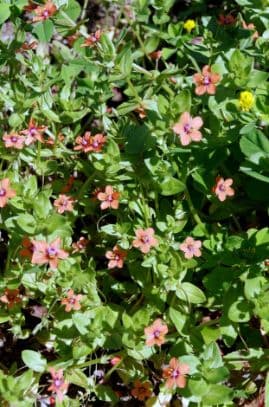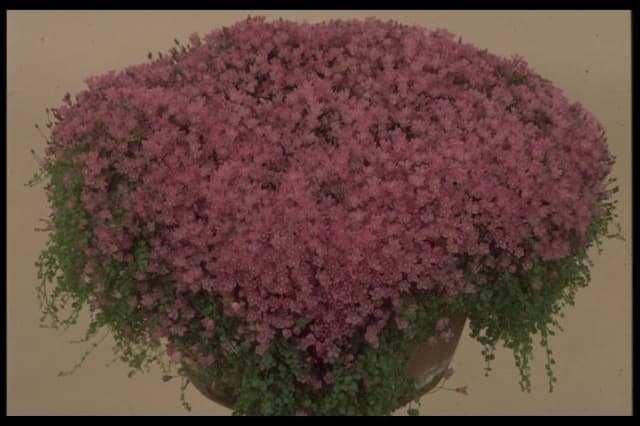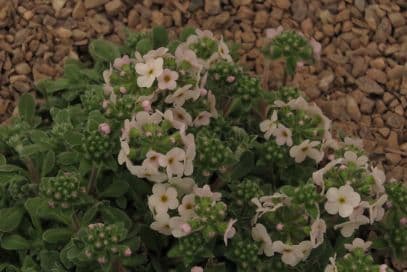Primula auricula 'Joel' (Au/s)

ABOUT
Primula auricula 'Joel' is a variety of the common name auricula. This plant is distinguished by its striking, colorful flowers and lush foliage. The flowers of this variety typically possess a vibrant, eye-catching palette that may include shades of yellow, red, pink, purple, and blue, often with contrasting centers or edges known as piping, which adds to their ornate appearance. The petals of the auricula 'Joel' are arranged in a circular pattern, radiating outwards from the center of the flower, giving it a unique and somewhat geometric appearance. The texture of the petals can be described as velvety, contributing to the plant's visual and tactile appeal. The foliage of the auricula 'Joel' comprises compact, green leaves that are slightly rounded with a somewhat fleshy texture. The leaves are often covered with a fine, whitish powder that can give them a frosted appearance. This powdery coating, commonly found on auricula leaves, is one of its distinguishing features. Overall, the appearance of the auricula 'Joel' exudes a sense of charm and delicacy with its colorful blooms juxtaposed against the backdrop of its attractive foliage, making it a popular choice for gardeners and plant enthusiasts seeking to add a touch of elegance and color to their collections.
About this plant
 Names
NamesFamily
Primulaceae
Synonyms
Bear's Ear, Auricula, Mountain Cowslip
Common names
Primula auricula 'Joel' (Au/s).
 Toxicity
ToxicityTo humans
The Bear's Ear, commonly known as Primula auricula 'Joel', is not considered highly toxic to humans. However, some people may experience skin irritation when handling the plant due to the presence of primin, a compound found in the plant's sap. Ingesting parts of the plant can potentially cause mild gastrointestinal upset, but significant toxicity is uncommon. If ingested, symptoms might include nausea, vomiting, or diarrhea. It is advisable to seek medical attention if symptoms persist or if ingestion is suspected, especially in children or individuals with sensitive systems.
To pets
The Bear's Ear, commonly known as Primula auricula 'Joel', is not considered highly toxic to pets. Similar to humans, contact with the plant's sap could lead to minor skin irritations in sensitive pets. If ingested, the plant could cause mild gastrointestinal irritation, which might present as vomiting or diarrhea. While severe toxicity is rare, pet owners should still exercise caution and prevent their pets from ingesting the plant. If a pet shows signs of distress after contact or ingestion, it is recommended to consult a veterinarian.
 Characteristics
CharacteristicsLife cycle
Perennials
Foliage type
Evergreen
Color of leaves
Green
Flower color
Mixed
Height
6 inches (15 cm)
Spread
8 inches (20 cm)
Plant type
Herb
Hardiness zones
5
Native area
Europe
Benefits
 General Benefits
General Benefits- Aesthetic Appeal: The Primula auricula 'Joel' adds vibrant color and visual interest to gardens with its unique and beautiful flowers.
- Attracts Pollinators: This plant attracts bees and butterflies, supporting the local ecosystem by aiding in pollination.
- Low Maintenance: Auricula 'Joel' is known for being relatively easy to care for, requiring minimal maintenance once established.
- Versatile Planting: It can be planted in borders, rock gardens, or containers, offering flexibility in garden design.
- Long Blooming Period: The Auricula 'Joel' typically has an extended blooming period, offering a longer display of flowers.
- Hardy Nature: It is tolerant of cold temperatures, making it suitable for growth in a variety of climates.
- Space Efficient: With its compact size, it is ideal for smaller gardens or spaces where every inch counts.
 Medical Properties
Medical PropertiesThis plant is not used for medical purposes.
 Air-purifying Qualities
Air-purifying QualitiesThis plant is not specifically known for air purifying qualities.
 Other Uses
Other Uses- The Auricula flowers can be used to create natural dyes, offering a range of colors from green to yellow, depending on the mordant used.
- In addition to their beauty, Auriculas are often grown for competitive showing, with enthusiasts striving for the perfect rosette of leaves and tiered flowerheads.
- The flowers of the Auricula can be crystallized and used as decorative, edible garnishes on cakes and desserts.
- Auricula leaves can be used in arrangements or as a subtle, decorative touch to gift wrapping or paper crafts for their unique shape and texture.
- The petals of the Auricula can be scattered in salads to add a pop of color and a slight peppery flavor similar to garden cress.
- Auricula flowers are used in potpourri mixes for their shape and color consistency when dried.
- The plant can be a muse for artists and poets, often appearing in still-life paintings and garden-inspired poetry.
- Auricula displays, known as "Auricula Theatres," are a historical and charming way of presenting these plants in gardens, becoming a garden feature themselves.
- Their vibrant colors make them an excellent candidate for botanical photography, inspiring both professional and amateur photographers.
- Auriculas can be used in educational settings, such as schools and nature programs, to teach about plant biology, hybridization, and horticulture.
Interesting Facts
 Feng Shui
Feng ShuiThe Auricula is not used in Feng Shui practice.
 Zodiac Sign Compitability
Zodiac Sign CompitabilityThe Auricula is not used in astrology practice.
 Plant Symbolism
Plant Symbolism- Uniqueness: The Primula auricula 'Joel', commonly known as 'Auricula' or 'Mountain Cowslip', possesses unique and vividly colored flowers, symbolizing the distinctiveness and individuality in the world of flora.
- Patience: As a perennial that blooms in early spring, the Auricula represents patience, implying the ability to wait for the right moment to reveal one's beauty and potential.
- Adaptability: Originating from alpine regions, this plant is accustomed to harsh conditions, signifying adaptability and the capacity to thrive regardless of the circumstances.
- Precision and Attention: The detailed patterns and often carefully bred varieties of the Auricula show a high level of meticulous care, implying the importance of precision and attention to detail.
 Water
WaterAuricula Primroses require moderate watering, ensuring the soil is moist but never soggy. Typically, water them with about 1/4 to 1/2 gallon per plant, every week, depending on the climate and weather conditions. During the active growing season in spring and fall, they may need more frequent watering, especially if the weather is dry. During the winter months, water them sparingly, just enough to prevent the soil from drying out completely. Always check the top inch of soil for dryness before watering again.
 Light
LightAuricula Primroses prefer bright, indirect light or partial shade. They thrive under the dappled sunlight of a tree or on an east-facing windowsill that receives morning light but is shielded from the harsh afternoon sun. Avoid placing them in full, direct sunlight during the hot summer months as it can scorch their leaves and flowers.
 Temperature
TemperatureAuricula Primroses prefer cool to moderate temperatures, ideally between 50°F and 70°F. They can withstand short periods outside of this range, with a minimum of around 40°F and a maximum of 80°F. The ideal temperature helps promote healthy growth and vibrant blooms. Extreme temperatures on either end can stress the plant and should be avoided.
 Pruning
PruningAuricula Primroses should be pruned to remove dead or fading flowers and to maintain a compact shape. Pruning can encourage a second flush of blooms and prevent the spread of diseases. The best time to prune is right after the main flowering period which usually occurs in spring. Prune them every few weeks during the blooming season to keep the plant looking tidy and to promote more flowers.
 Cleaning
CleaningAs needed
 Soil
SoilBear's Ear thrives in well-draining soil with good organic content, preferring a slightly alkaline pH between 6.5 and 7.5. The ideal soil mix consists of equal parts loam, peat, and perlite or grit for drainage. Regular feeding with a balanced, slow-release fertilizer will promote healthy growth.
 Repotting
RepottingBear's Ear should be repotted every one to two years to refresh the soil, ideally after flowering. This helps to prevent the compacting of soil and replenishes nutrients, ensuring the plant continues to flourish.
 Humidity & Misting
Humidity & MistingBear's Ear prefers moderate humidity levels, ranging from 40% to 60%. Avoid extremely high humidity to prevent rot and fungal issues, especially in stagnant conditions without adequate ventilation.
 Suitable locations
Suitable locationsIndoor
Place Bear's Ear in bright, indirect light with good air flow.
Outdoor
Keep Bear's Ear in partial shade and protect from harsh elements.
Hardiness zone
4-8 USDA
 Life cycle
Life cyclePrimula auricula 'Joel', commonly known as Auricula or Bear's Ear, begins its life cycle when seeds are sown in moist potting soil and germinate, typically within two to three weeks under optimal conditions. The seedlings develop true leaves and establish a small rosette, progressing to a juvenile stage whose growth culminates in the formation of a larger, more robust rosette of leaves. During spring, mature plants produce stalks topped with clusters of showpiece flowers, which are often ornately patterned and brightly colored, attracting pollinators. After blooming, the plant sets seed, which can be collected when the capsules ripen for propagation or allowed to self-sow if conditions are favorable. Throughout the year, Auricula 'Joel' may undergo vegetative growth, maintaining its foliage, and in some climates, it remains evergreen. The plant enters a period of dormancy during colder months, reducing metabolic activities, only to resume growth with the onset of warmer temperatures in spring.
 Propogation
PropogationPropogation time
Spring-Early Summer
The most popular method of propagation for the Primula auricula 'Joel', also known as Auricula, is through division. This typically occurs after the plant has finished blooming, which is usually in late spring or early summer. To propagate by division, the clumps of the parent plant should be gently lifted from the soil and carefully separated into smaller sections, ensuring that each new piece has a portion of the roots intact. The divisions can then be replanted into well-draining soil at a depth where the crown of the plant is just at soil level. It's important to water the new plants thoroughly after planting to help establish them. Division not only helps propagate new Auricula plants but also rejuvenates older clumps that may have become too dense over time.









